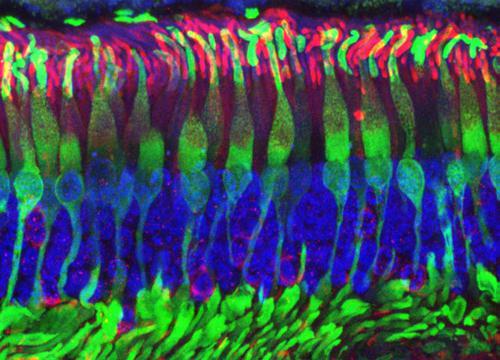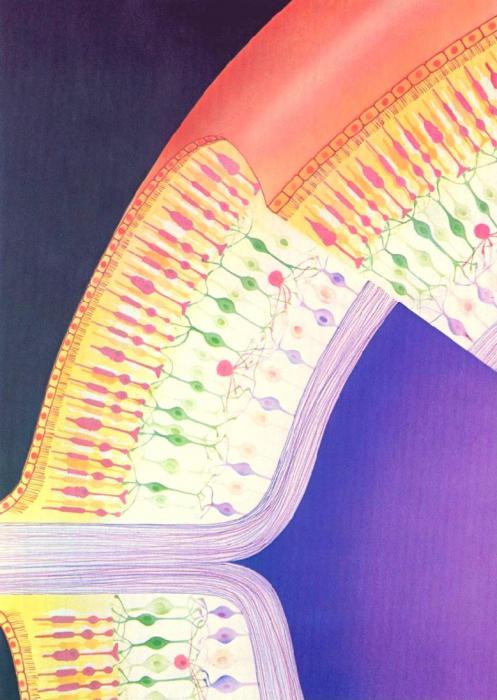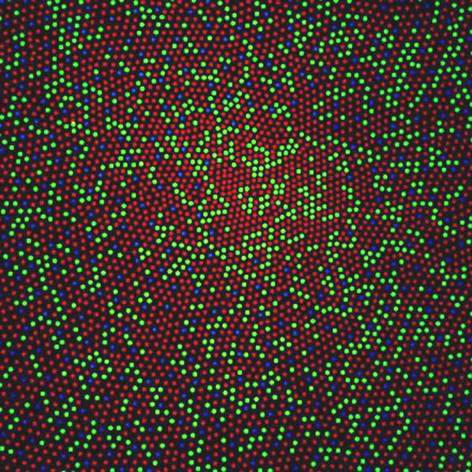Sticks and cones. Retinal cones. The structure of the retina - diagram
Vision is one of the ways to know the world around us and navigate in space. Despite the fact that other senses are also very important, with the help of the eyes, a person perceives about 90% of all information coming from the environment. Thanks to the ability to see what is around us, we can judge the events taking place, distinguish objects from each other, and also notice threatening factors. Human eyes are arranged in such a way that in addition to the objects themselves, they also distinguish the colors in which our world is painted. Special microscopic cells are responsible for this - rods and cones, which are present in the retina of each of us. Thanks to them, the information we perceive about the type of surroundings is transmitted to the brain.
The structure of the eye: diagram
Despite the fact that the eye takes up so little space, it contains many anatomical structures, thanks to which we have the ability to see. The organ of vision is almost directly connected with the brain, and with the help of a special study, ophthalmologists see the intersection of the optic nerve. has the shape of a ball and is located in a special recess - an orbit, which is formed by the bones of the skull. To understand why the numerous structures of the organ of vision are needed, it is necessary to know the structure of the eye. The diagram shows that the eye consists of such formations as the lens, the anterior and posterior chambers, the optic nerve and membranes. Outside, the organ of vision is covered by the sclera - the protective frame of the eye.
Shells of the eye
 The sclera performs the function of protecting the eyeball from damage. It is the outer shell and occupies about 5/6 of the surface of the organ of vision. The part of the sclera that is outside and goes directly to the environment is called the cornea. It has properties due to which we have the ability to clearly see the world around us. The main ones are transparency, specularity, moisture, smoothness and the ability to transmit and refract rays. The rest of the outer shell of the eye - the sclera - consists of a dense connective tissue base. Under it is the next layer - the vascular. The middle shell is represented by three formations located in series: the iris, ciliary and choroid. In addition, the vascular layer includes the pupil. It is a small hole that is not covered by the iris. Each of these formations has its own function, which is necessary to ensure vision. The last layer is the retina of the eye. It communicates directly with the brain. The structure of the retina is very complex. This is due to the fact that it is considered the most important shell of the organ of vision.
The sclera performs the function of protecting the eyeball from damage. It is the outer shell and occupies about 5/6 of the surface of the organ of vision. The part of the sclera that is outside and goes directly to the environment is called the cornea. It has properties due to which we have the ability to clearly see the world around us. The main ones are transparency, specularity, moisture, smoothness and the ability to transmit and refract rays. The rest of the outer shell of the eye - the sclera - consists of a dense connective tissue base. Under it is the next layer - the vascular. The middle shell is represented by three formations located in series: the iris, ciliary and choroid. In addition, the vascular layer includes the pupil. It is a small hole that is not covered by the iris. Each of these formations has its own function, which is necessary to ensure vision. The last layer is the retina of the eye. It communicates directly with the brain. The structure of the retina is very complex. This is due to the fact that it is considered the most important shell of the organ of vision.
The structure of the retina

The inner shell of the organ of vision is an integral part of the medulla. It is represented by layers of neurons that line the inside of the eye. Thanks to the retina, we get an image of everything that is around us. All refracted rays are focused on it and are composed into a clear object. The retinas pass into the optic nerve, through the fibers of which information reaches the brain. There is a small spot on the inner shell of the eye, which is located in the center and has the greatest ability to see. This part is called the macula. In this place are visual cells - rods and cones of the eye. They provide us with both day and night vision of the world around us.
Functions of rods and cones
 These cells are located on the retina of the eye and are essential for seeing. Rods and cones are converters of black and white and color vision. Both types of cells act as light-sensitive receptors in the eye. The cones are so named because of their conical shape, they are the link between the retina and the central nervous system. Their main function is the conversion of light sensations received from the external environment into electrical signals (impulses) processed by the brain. Specificity to recognize daylight belongs to cones due to the pigment they contain - iodopsin. This substance has several types of cells that perceive different parts of the spectrum. Rods are more sensitive to light, so their main function is more difficult - providing visibility at dusk. They also contain a pigment base - the substance rhodopsin, which becomes discolored when exposed to sunlight.
These cells are located on the retina of the eye and are essential for seeing. Rods and cones are converters of black and white and color vision. Both types of cells act as light-sensitive receptors in the eye. The cones are so named because of their conical shape, they are the link between the retina and the central nervous system. Their main function is the conversion of light sensations received from the external environment into electrical signals (impulses) processed by the brain. Specificity to recognize daylight belongs to cones due to the pigment they contain - iodopsin. This substance has several types of cells that perceive different parts of the spectrum. Rods are more sensitive to light, so their main function is more difficult - providing visibility at dusk. They also contain a pigment base - the substance rhodopsin, which becomes discolored when exposed to sunlight.
Structure of rods and cones
These cells got their name due to their shape - cylindrical and conical. Rods, unlike cones, are located more along the periphery of the retina and are practically absent in the macula. This is due to their function - providing night vision, as well as peripheral fields of vision. Both types of cells have a similar structure and consist of 4 parts:

The number of photosensitive receptors on the retina varies greatly. Rod cells make up about 130 million. The cones of the retina are significantly inferior to them in number, on average there are about 7 million of them.
Features of the transmission of light pulses
 Rods and cones are able to perceive the light flux and transmit it to the central nervous system. Both types of cells are able to work during the daytime. The difference is that cones are much more sensitive to light than rods. The transmission of the received signals is carried out thanks to interneurons, each of which is attached to several receptors. Combining several rod cells at once makes the sensitivity much greater. This phenomenon is called "convergence". It provides us with an overview of several at once, as well as the ability to capture various movements occurring around us.
Rods and cones are able to perceive the light flux and transmit it to the central nervous system. Both types of cells are able to work during the daytime. The difference is that cones are much more sensitive to light than rods. The transmission of the received signals is carried out thanks to interneurons, each of which is attached to several receptors. Combining several rod cells at once makes the sensitivity much greater. This phenomenon is called "convergence". It provides us with an overview of several at once, as well as the ability to capture various movements occurring around us.
The ability to perceive colors
Both types of retinal receptors are necessary not only to distinguish between day and twilight vision, but also to determine color pictures. The structure of the human eye allows a lot: to perceive a large area of the environment, to see at any time of the day. In addition, we have one of the interesting abilities - binocular vision, which allows us to significantly expand the field of view. Rods and cones are involved in the perception of almost the entire color spectrum, due to which people, unlike animals, distinguish all the colors of this world. Color vision is largely provided by cones, which are of 3 types (short, medium and long wavelengths). However, rods also have the ability to perceive a small part of the spectrum.
